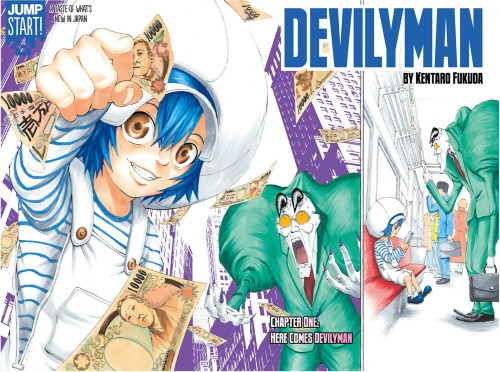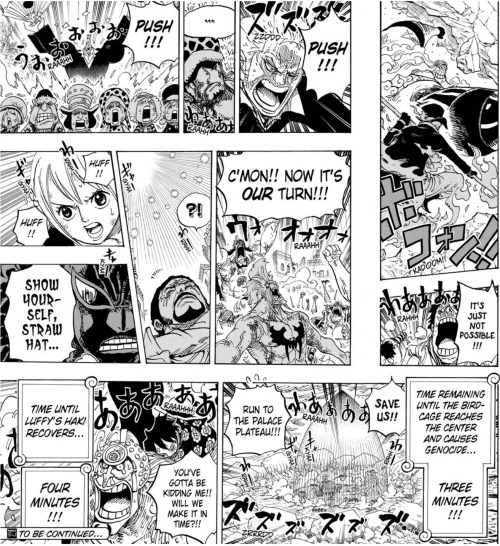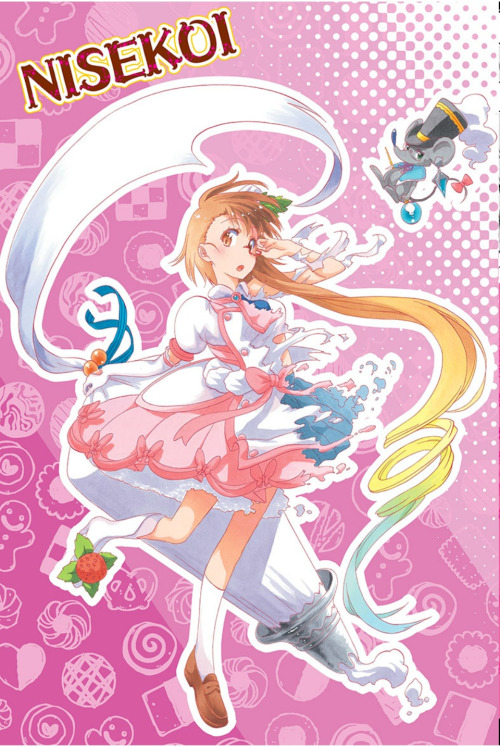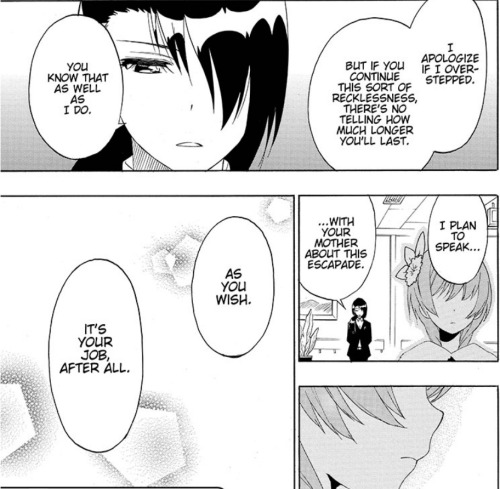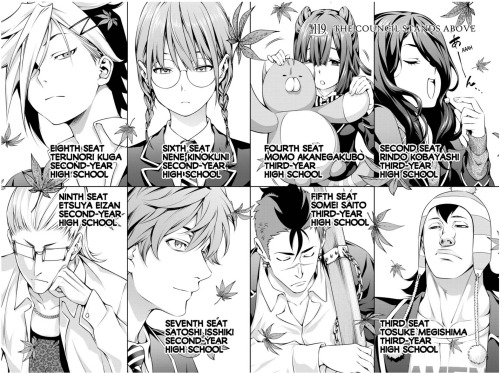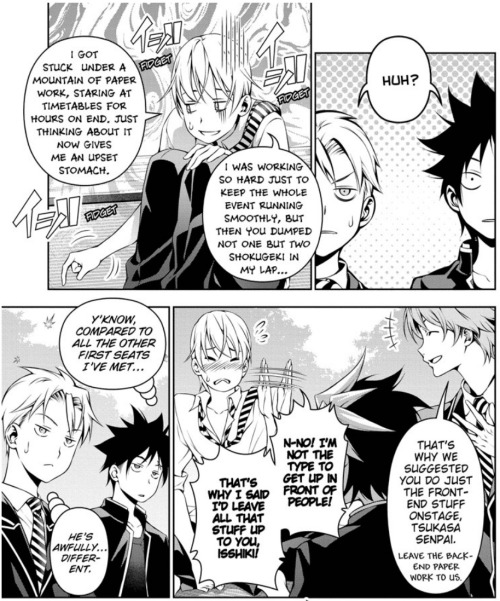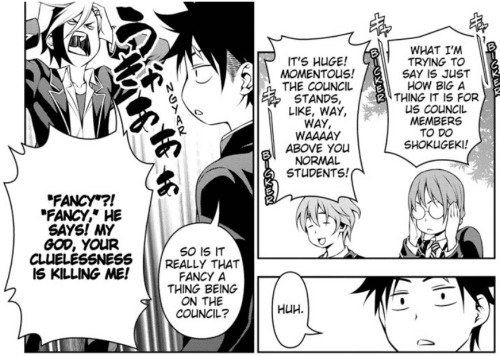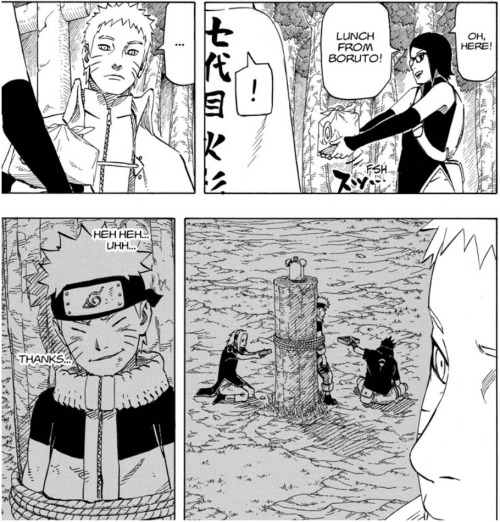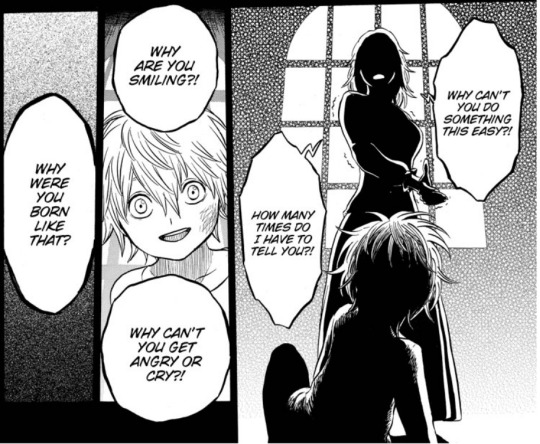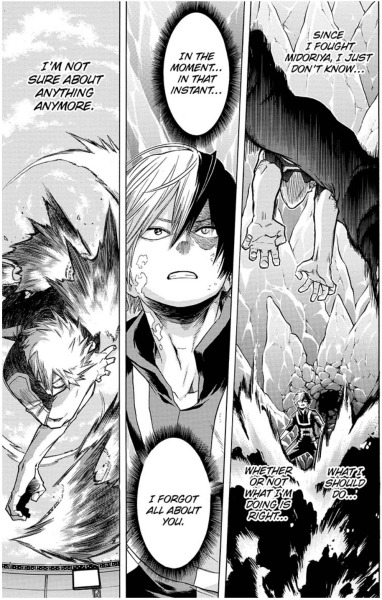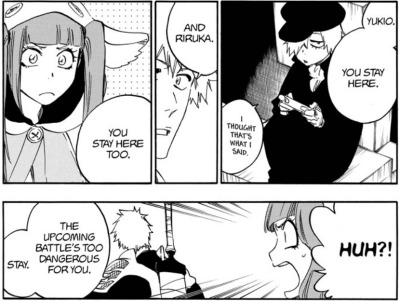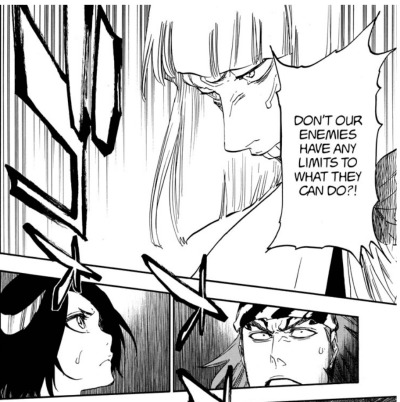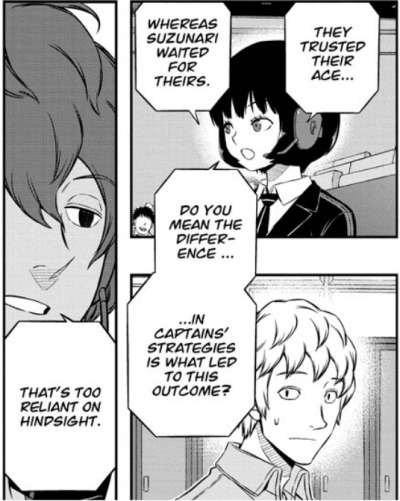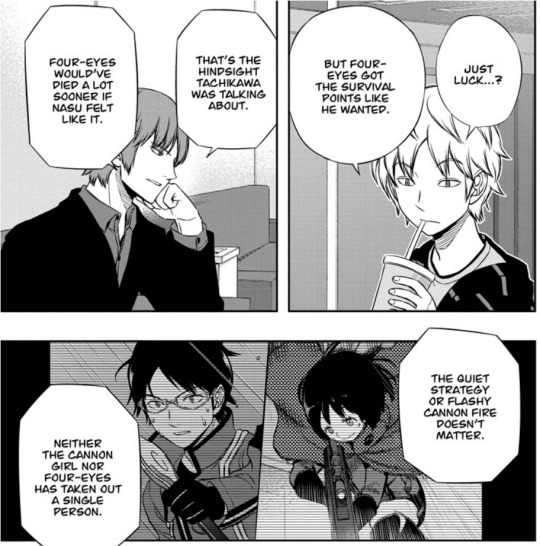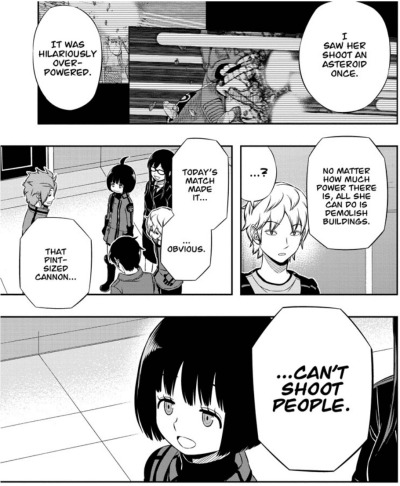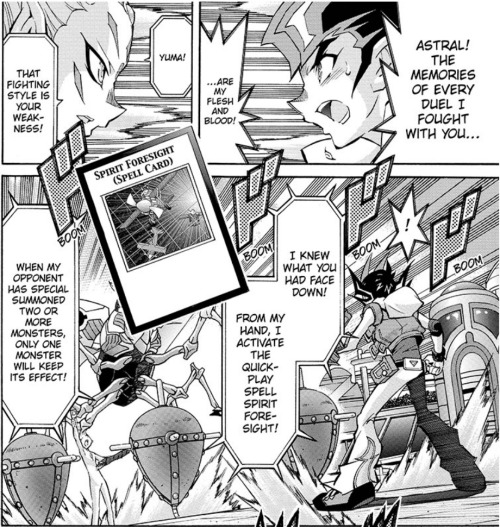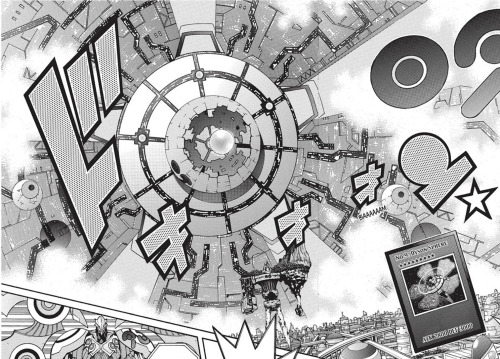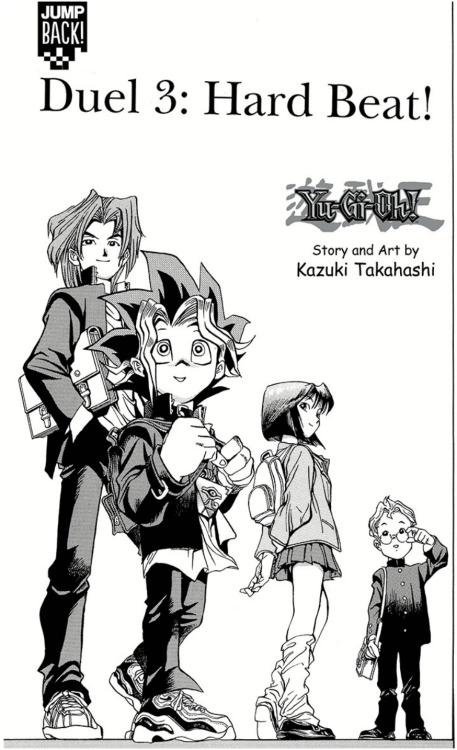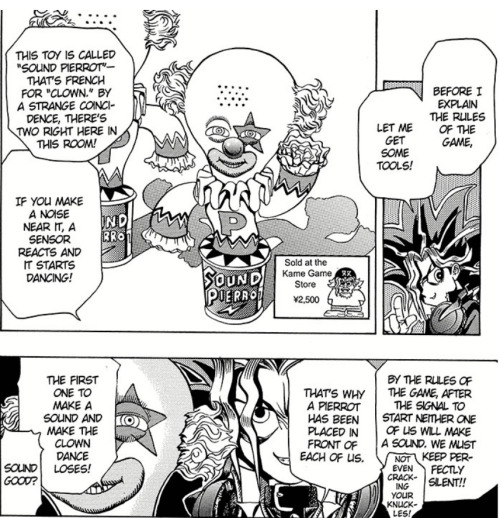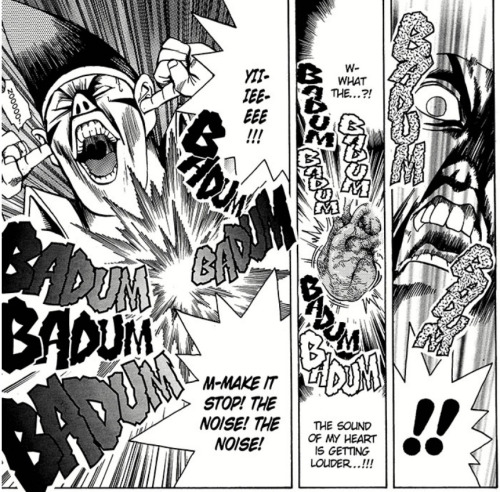05.27
So remember when I wrote that review of a bunch of currently-running manga chapters back in January? Remember how I said that I was going to do those every month and how I never followed up on that? Yeah…my bad. I got caught up in real-world shenanigans and the backlog of material I wanted to cover grew so big that I the task of going back to it seemed daunting. So, I’ve decided to skip writing about the manga chapters of January through April 2015 and just move on to May. It’s disappointing, I know, but I hope to write some “Year so far” type reviews for a couple series sometime or so to make up for that (not making promises, though).
In any case, it actually took me a ridiculously long time to write that first manga roundup I did. There’s a surprising amount of series that have a lot happen in them on a week to week basis, so much so that trying to review multiple series in chunks at a time can be a bit time-consuming. So, to make things more manageable I’m going back to doing weekly reviews of a select group of manga series like I used to do on the forums. And of course, the digital Weekly Shonen Jump imprint offered by Viz is a perfect digest for me to tackle for weekly reviews since it offers a good chunk of the most notable and popular weekly series both from it’s parent magazine and the manga world at large. The format is pretty simple; I’ll review each series in the issue, in the order they are presented in the table of contents. And I mean every series, even the ones I don’t normally read or care for. These will be complete and thorough issue reviews.
Keep in mind, however, that I will only be addressing series running in the english Jump, not every series in the original japanese edition. As such, I will not be covering series like Assassination Classroom and Haikyuu!!, among others. Those will be saved for whenever I resume the Monthly Roundups. So with that said, let’s get started and take a look at this week’s issue of Jump: 2015, No.26!
Devilyman chapter #1 – “Here Comes Devilyman”
I really wanted to start these issue reviews two weeks ago, when Straighten Up! started, but I didn’t end up finding the time then, so I’ll be starting alongside the beginning of Jump’s latest newcomer, Devilyman, instead. For those of you who don’t already know, Viz’s Jump now previews most of the new series that debut in Jump in Japan. Through this “Jump Start” initiative, they publish the first three chapters of the new series, and then after gauging the reaction to them via social media and the weekly surveys, chooses one of the set to add to the english Jump. This time, Viz has opted not to run one of the new series, Lady Justice, as a Jump Start, so there are only two: Straighten Up!, which will publish it’s third chapter this week, and Devilyman, which debuts in this issue. So what is Devilyman about?
I think you can guess the premise just by looking at this one panel. Devilyman uses the common trope of the friendly, ineffectual devil often used in many a comedy show. Our titular devil, named Madogiwa, is your run of the mill salaryman who, for some reason or another, needs to make a billion yen fast or else his ass is fired (and he only has two years until retirement too!). The basic concept of a salaryman demon immediately reminds me of Ugly Americans, and I wouldn’t be surprised if his workplace and co-workers are like a kid-friendly version of that, assuming we’ll get ever get to see them.
Unlike other examples of his archetype, Madogiwa doesn’t look nor ever gives off a threatening vibe, though his appearance does freak people out. Just by looking at him, you can guess this is a pretty pathetic down on his luck white collar guy who’s always tired but still manages to cling to some hopeful optimism and naivety. And sure enough, everything he does in this chapter matches that description, right down to things liking getting cold feet at getting a child to sign a bad contract and falling to the oldest scam in the book and loaning out ten million yen to a guy who claims to need the money to help cure his sick wife. In contrast your typical hotblooded shonen teenager, the naive character of the elderly and world-weary Madogiwa comes off as more sympathetic. It certainly helps that he doesn’t spout tired lines and cliches about wanting to be the best at something and all that jazz, but the core reason is that we can guess that he’s a guy who’s lived a long life and really should be as world-wise as he is world-weary. Instead, he believes the best in people and tries to be a good person in spite of the fact his line of work is to force people to sign contracts that will ultimately ruin their lives. It’s a good construction of design and character, making him a fun and likable protagonist that you can easily get behind and support.
As a comedy, Devilyman needs to play with expectations, and the easiest way to do that is to have characters and situations that don’t behave and develop the way you’d expect. The opening chapter of Devilyman presents many ironies, the most prominent being it’s central two characters; a devil who’s a well-meaning nice guy and a little boy who’s a precocious and manipulative psychopath. Devilyman doesn’t really have new ideas as far as these go, but it does use them to provide a solid foundation for it’s characters and a story. The plot of the first chapter goes through it’s beats in a fast and fun manner, some elements of the story such as Madogiwa being sucked being predictable, others like the freakishly evil little boy Aeru blackmailing one hundred people to help his “friend” out of his jam being surprisingly clever. I didn’t laugh out loud at any of the jokes in this debut chapter, but it did well to humanize and endear me to the central characters. Considering that interesting and dynamic characters are key to any good comedy-focused story, Devilyman shows a lot of promise. Doubly so due to the mystery behind the character of Aeru, and why a seven little boy is this good at conning and manipulating people, and the interesting world behind the series as well, including the notion there are other devils like Madogiwa out there selling dangerous powers to people at high risk to themselves. Devilyman‘s premise offers many possibilities for interesting story-lines, and it’ll be interesting to see exactly what the mangaka makes of them.
There’s a lot to like and be interested in Devilyman between it’s deceptively well-done art and character design and solid writing and foundation, and having expected it to be another typical run of the mill manga comedy, this opening chapter was quite a pleasant surprise. It’s still too early for me to judge how well this series will work in the long run, since it’s premise is one that I can’t imagine can last too long without having to change into something more complex. Right now, though, it’s certainly got me attention, and I look forward to spending at least another two weeks with it.
One Piece chapter #787 – “Four Minutes Before”
Every One Piece arc has that big chaotic point in the arc where the danger is at it’s highest and there’s a shit-ton of things going on all at once while things build up to one huge climactic payoff. This is that chapter for the Dressrosa arc; showing the characters react in panic to the ticking clock of the birdcage and Doflamingo’s rampage, as everyone buys time for Luffy to regain his strength and re-engage Doflamingo in their final showdown. There’s a lot of tension and desperation pervading the chapter, and it feels like that this all building to the biggest moment of the entire arc; Luffy’s comeback and Doflamingo’s fall, which will of course mean the end of the Birdcage and Dressrosa’s long awaited liberation from the clutches of the Don Quixote family’s tyrannical reign. This should be the most exciting, nail-biting moment of the entire arc. In execution, however, it doesn’t do much to impress.
The big problem with this chapter is that despite this being supposedly the most intense and climactic point in the arc, the way Oda’s been writing this series these last two years makes it just another typical OP outing these days. Every chapter of OP now switches between characters and plot lines at a break-neck and unrelenting pace. OP no longer takes the time to slow itself down and let important moments sink in and give readers a breather. There was never any calm to this arc; it’s all just been one big, messy storm. So it’s hard to really buy into what the chapter is trying to go for in terms of it’s emotional tone, or how cohesive the scenes relate to each other. It’s appreciable that the rest of the Straw Hats and the gladiators aren’t just doing nothing while the Birdcage is looming down on them and trying to do something to stall it and help people just a little, but there’s been too much going on in this arc for the chaos of these scenes to register as meaningful. It’s just feels like more stuff happening, and that’s the last thing OP needs nowadays.
Sometimes, less is more. I think the above series of panel from the end of the chapter sums up everything that’s going on just as effectively as the chapter as a whole did. I would’ve liked Oda to instead focus this chapter on just one thing – the reunion of Luffy and Sabo, and Sabo taking over the fight with Burgess. This is the one section of the chapter that was really effective, with some cool moments from Sabo and the interesting development that Blackbeard’s crew is indeed hunting Devil Fruit powers. It would’ve been nice to see more of an exchange between Luffy and Sabo, with a more potent emotional moment, and then a more extended and dynamic battle between Sabo and Burgess. That strikes me as the makings of a great OP chapter of it’s prime days, instead of what we got instead, yet another piece-meal offering that at this point just feels exhausting rather than fun to read.
This is far from a bad chapter, but it does feel like a waste. I really do think that one two-page spread at the end of the chapter told us everything we really need to know and this chapter could’ve been better spent on other, more interesting things. It also just reminds me of how fatigued I am at this arc and why I’m feeling so fatigued about it, which is a damn shame because this yet another chapter shows that OP still has a lot of really great ideas, but wastes them by developing them in such a messy way. As much as I’ve wanted to, I’ve found it increasingly difficult to be enthusiastic about the series as the conflict with Doflamingo’s been winding down these last couple of weeks. I just hope the payoff to this arc is worth all this meandering and superfluous build-up.
Nisekoi chapter #171 – “Heart”
A chapter about Marika, yet the cover page highlights Onodera instead. I think that’s the costume from that magical girl spinoff about her that I think is getting adapted as part of the anime this week. I suppose it’s timely promotion, but considering the contents of this chapter, it’s really ill-fitting.
Nisekoi has been strange lately. These last few story arcs have been addressing Raku’s relationship with each of the girls in his harem in a surprisingly serious manner, and in a way that, gasp, is actually advancing the story and character arcs. But while Chitoge and Onodera’s arcs still ended with status-quo upholding resolutions, this arc with Marika has prompted a game-changing revelation that, surprisingly, seems like it’s not going anywhere soon. When Honda told Raku that Marika “didn’t have much time left,” I assume that was going to be some bullshit misleading thing that would ultimately be played for laughs….but no. No apparently this is actually a thing. And Marika, who until now has been the most shallow and uninteresting character in the series by far, is actually getting legitimate and respectable character development. We learn that her crush on Raku is rooted in legitimate and understandable feelings of appreciation and nostalgia, and upon hearing this, Raku is forced to actually think about Marika’s feelings for him seriously for once. Heck, the readers are forced to take Marika seriously for once!
Am I in bizarro world? Is this really Nisekoi I’m reading? Is Komi actually giving depth to a character that he has gone on record saying that readers like primarily because she’s the most simple and straightforward of the bunch? My expectations of where Nisekoi is going have been shaken up. With the development that Marika’s cryptic condition is indeed serious, possibly life-endangering, so much so that it seems inevitable that we explore her background, family, and personal history more deeply, Komi seems to be stepping up to do what few manga romcom writers dare to – take a risk. He’s taking his most popular character, challenging what makes her so popular, and instead trying to make a more substantial character, and a more interesting storyline, out of her. Komi can be a good writer when he can break free of the limitations writing a shonen romcom imposes on him, and if he doesn’t chicken out of this set-up, he has the potential to elevate his series into something better than what’s it’s been for the last few years. Nisekoi has been progressively more interesting to read since the year began, but this chapter is the first to really impress me and make me speculate about it with uncertainty about where it might go. Certainly, Komi could play the safe route at the last minute, but I’m an optimist, and I’m giving him and his series the benefit of the doubt. You’ve got my attention, Nisekoi. Show me what you can be capable of.
Toriko chapter #324 – “Departure of Smiles!!”
The last few chapters of Toriko have been devoted to some important world building and question answering, and while these have been interesting and exciting to some readers, including myself, I know other have gotten tired of it at this point. As such, I’m glad the story is finally moving forward again, though the way it is surprises me. Having a deadline to reach in order to gather all of Acacia’s full course is a good way to introduce more tension into the story, but I was not expecting the extended cast to separate and go after the remaining dishes of the full course in smaller groups. Of course, this makes a lot of sense since they have a lot of ground to cover, but they probably should have gone further with the idea and have each of the four kings go after an ingredient on their own. It would have been a good chance to give more development to Coco, Sunny, and Zebra, considering most of the character development since the timeskip started has focus squarely on Toriko and Komatsu. Perhaps that will still happen down the line, and the chapter didn’t make it clear. Still, I’m pumped that the entire extended cast is involved with this. Sure, it’s a bit ridiculous that just about everyone is in the Gourmet World now, but I’m hardly adverse to seeing more of characters like Livebearer, Melk, and Chin, to name just a few.
But the biggest takeaway of the chapter is Komatsu’s growth, declaring that he will go after Acacia’s fish course, Another, by himself. Not only is this a smart development considering he’s just spent the entire Pair arc comatose, but it’s satisfying to see what was once a nervous and unconfident character really take initiative and ask his friends to allow him to repay his debt to them for saving his life by doing something that only he he is capable of doing. It’s a great step forward for his character, and I’m excited at the prospect of a Komatsu-centric arc.
Speaking of being excited at prospects, it looks like Terry, Queen, and Kiss are going to seek training from Monkey King Bambina. And that is fucking amazing. Especially if it means Bambina himself is going to return to the story again sometime in the future. Hopefully sometime in the near future. Bambina is awesome. Also, I love the idea that Bambina has kidnapped Zonge and his lackeys are is pulling them around on a sled now. Poor Zonge just can’t catch a break, can he?
All in all, this was a well-put together chapter providing interesting and exciting developments mixed in with some good character moments, some fun comedy, and a fairly touching close to the Pair arc. That said, I’m glad that all the wrap-up is out of the way, and we can get moving to another arc. Heh, see what I did there? Because the next arc is literally going to be called the Anoth…yeah, I know. Bad joke. Let’s move on now.
Food Wars! Shokugeki no Soma chapter #119 – “The Council Stands Above”
The Council of Ten. Totsuki Academy’s elite group of student chefs, who’s culinary capabilities far exceed that of those of the general student body. Looking at this eclectic group of rogues, one would assume that the first seat, the best student chef in the entire school, would be an intimidating, confident, and domineering adversary with charisma that Yukihara Soma can’t possibly hope to match with his still developing art. Behold, everyone, the main antagonist of the next arc of Food Wars! Shokugeki no Soma!!!…
…Yes. Truly fearsome. Seriously, though, I love how Food Wars! plays with expectations with it’s characters. I love how the Council of Ten are just a bunch of eccentrics with their own little quirks and how they all hate one another, I love how the first seat of the council is the least impressive looking and most weak-willed character of the bunch, and I love how Soma doesn’t give a shit about whatever “fancy” prestige the council has and just wants to challenge one of them to a shokugeki to test himself and grow as a cook.
It’s cool to learn exactly why being a member of the Council of Ten is a big deal these characters should strive for. It’s not the title that’s important. Lord knows Soma doesn’t give a shit about that. Rather, it’s about the opportunities given to those with it. Being on the council means having access to funds, ingredients, and materials you’d be hard pressed or incapable of getting otherwise, and that access is paramount to evolve as a cook on the level of the most elite chefs in the world. Naturally, having all those resources at their disposal, members of the council of ten have a huge advantage over the rest of the student body. They are far closer from competing in the big leagues, and it’s paramount Soma and the rest get on their level if they want to keep up and make a name for themselves in the culinary world. And until they can prove there is something they could rival or beat them at in cooking, they won’t bother doing a shokugeki with any of them.
I just love how seriously Soma is thinking about the day’s events and Kuga’s proposal while riding a fucking moped. I also love how Tadokoro is somehow keeping up with him on a normal bicycle while holding a look on her face like she still can’t believe everything she just saw. Their conversation is really great too. Tadokoro ain’t one to rock the boat, but even she’s miffed that the Elite Ten talked down to them like they did and is thinking about a way for Soma and her to demonstrate their skills and issue a challenge. Their opportunity seems to lie in the next big event of Totsuki academy, which is, of course, a school festival.
Yes. Yes there is, Soma. I love his little gleam of interest here. He knows this is a chance to show up the Elite Ten, and he ain’t going to let it slip by him. He’s going to give them a show they won’t forget. And I can’t wait to see how.
Naruto: The Seventh Hokage and the Scarlet Spring chapter 700+4 – “Chance Meeting (2)”
I think Cho Cho needs to seek help. I mean, she’s fucking delusional. Not because she thinks that people are actually fighting over her. That’s fine. Nah, she’s clearly loco because she somehow has it in her head that Naruto is an “awesome” and “cool” dude. The poor girl is out of her damn mind!
I got sick of the Naruto-worship Kishimoto kept writing time and time again in the past, so seeing it pop up here was pretty annoying. Naruto the character, though, is honestly the most likable I’ve seen him in years. Mostly because he clearly has matured in age while not losing the good qualities he had in his youth. He’s sensible and down-to-business, but is still approachable and compassionate, and I quite enjoyed his exchanges with Sarada in the chapter. I actually really got a laugh out of him explaining what kind of man Sausuke was to Sarada, and saying that he was basically as good as he was except for being totally anti-social and rude, but capping it all off by saying that he was, and still is, his rival. It’s a sweet sentiment made sweeter by the fact that Sarada, who never knew her father, is given more confidence by her connection to him by Naruto’s words about how much she resembles him.
Though Naruto took a lot of focus in the chapter, the star of this spinoff is still Sarada, and this is her story. Naturally, having her hopes and idea about the kind of man her father is raised by Naruto’s words about him, she ditches him and Cho-Cho so she can meet up with him faster. Obviously you can predict the ending of the chapter; Sasuke not recognizing his own daughter and attacking her, but it doesn’t make it any less effective. What sells the tragic element of it is probably the one panel where Sarada envisions herself giving her dad a big ol’ hug while he pats her head. In her mind he’d ideally an approachable, friendly father figure she can rely on and be comfortable around, giving her the same sense of security and confidence that she felt being around Naruto. But Sasuke is clearly no father figure. Add being a deadbeat dad as another reason to hate the asshole. Obviously, this misunderstanding will get cleared in the next chapter and Sarada and Sasuke should reach some kind of understanding with one another by the end of this mini-series, but I seriously hope they don’t just forgive him for being away and never being there for his daughter in her formative years. Then again, Sasuke was forgiven for murdering scores of innocent people and trying to destroy the world, so…
Off tangent, I don’t get why Naruto flashed back to Kakashi’s test when Sarada gave him the bento Hinata and Boruto prepared for him. The only similarity between the two situations is that he’s being given a bento. Is there some kind of thematic connection I’m missing here, or is Naruto just being spontaneously nostalgic? It just strikes me as an odd and superfluous callback.
Black Clover chapter #14 – “Friends”
I’ve been steadily growing fonder of Black Clover since it first debuted, but this arc has really piqued my interest in it, and I really liked this latest offering. In the last chapter we saw a bit more of the Black Bulls’ resident “fighting fiend” Luck’s personality as he took on the still-unnamed captain of the Diamond Kingdom mages, which led to some interesting bits of conversation between the two as well as some well-done action scenes. In this chapter, we actually get a glimpse into why Luck might be the way he is. Luck was abused by his mother in his childhood for being incapable of the most basic of tasks or showing normal human emotions, and ostracized by his community because of that behavior. He finally found acceptance when he beat a noble mage with his magic, which resulted in his mother showing him affection for the first time. This ingrained in him a need to win and keep winning in order to appease her and the people around him. In just a few pages, Tabata gives the character a strong layer of depth on which we can recognize and evaluate his behavior, and promises further exploration and development of him down the line. I appreciate the brevity and simplicity of the approach, not wasting an entire chapter to giving a secondary character a fleshed-out backstory this early in the series, but giving just enough to make him a more realized and fascinating character. I already enjoyed Luck from his actions in previous chapters, but knowing why the way he is just makes me all the more endeared to him. This guy better not be pushed to the side after this arc is over!
But Luck’s backstory is just part of what makes this chapter so cool. The core of this chapter is really the build-up to Asta and Yuno stepping in to help their seniors in their guilds out in the battles with the Diamond Mages, in spite of being told not to. While nothing new in terms of how the trope has gone in previous battle shonen, the execution employed here puts it to another level. The chapter cuts back between both battles as Asta and Yuno voice their concerns on whether they should help, and just when both battles look the most desperate for the respective leaders, they swoop in a fantastically drawn two-page spread and save their lives. Even though they have other priorities they were tasked with, both characters grew up valuing the friends they made since they didn’t have any family of their own. That’s only justification they need to ditch their tasks and help out in the battles instead. It’s a common shonen sentiment, but incredibly effective to the point I forgot that and just thought it was goddamn awesome.
What really puts this over the top for me is how the chapter balanced the parallel events of the chapter structurally. During the middle of the chapter, when both Asta and Yuno are debating whether to help in the battle or retrieve to the treasure, there are three successive pairs of pages wherein one page shows what’s happening to Black Bulls while the second focuses on the Golden Dawn, both side by side. Hence, you get a great sense of how both these events are progressing in real time and playing out simultaneously. This all builds to that brilliant two-page spread in which both Asta and Yuno pull a big damn heroes moment and save their sempais. Then the following page is structured in a way where the top and bottom sections focus on Asta and Yuno responding to their the question of why they came back, while the middle of the page shows a shared flashback between the two that gives their motivation. And then the final page gives their response, where both give the same answer of “His Friend!!!” The chapter balances both Asta and Yuno’s story lines equally and portrays the actions in the chapter in an intriguing way by using the way the series is layed out in Jump to it’s full advantage. In addition, it compliments it’s layout and panel structure to great effect in the way it builds both stories separately and then ultimately mashes them together to elicit an intense and exciting payoff and “fuck-yeah!” vibe. It’s a structurally brilliant chapter that makes full use of the manga medium to draw out the most mileage out of it’s contents in a meaningful way.
If and when this is adapted into an anime, losing the interesting way Tabata developed and contrasted the events in this chapter is no doubt going to weaken it’s effect. As I said, in terms of the bare-bones content, it’s nothing new for the genre. But Tabata found a way to make it feel exciting, fresh, awesome, and even emotionally-poignant. In case you couldn’t tell, I was extremely impressed with this chapter. It shows a sense of creativity and an understanding of the strengths of manga as a medium that few contemporary battle shonen seem to have even a sliver of. After this chapter, I’d think it unfair to dismiss Black Clover as yet another Jump battle manga. The contents might not be anything special yet, but the mangaka clearly knows how to make a darn effective and fun comic, and after this chapter, he’s got my full attention and support.
Straighten Up!! Welcome to Shika High’s Competitive Dance Club chapter #3 – “Shall We Dance Club?”
The third chapter of Straighten Up is a pretty straight forward “MC finally joins the club chapter.” You can say that’s all that happens in the chapter and leave it at that, I suppose. However, what’s drawn me to the series lies in it’s excellent characterization and the way it’s developed itself so far. The way these first three chapters have been structured is very much like how the titular Dance Club entices new members to join. Impress us with a flashy display of the dancing, then get to know what the Club is all about and the basics, and finally let us think over whether we want to read it by getting us to think of what the club and the people in it have to offer us. It’s a somewhat slow pace, especially since dancing is not an adrenaline-pumping sport people can really grasp along the same way basketball or baseball are, so it’s a definite risk in terms of attracting shonen readers for the long haul. Even so, quality-wise it’s plenty solid and a nice read.
Really, it’s the chemistry between the MCs and the reasons why they join they want to join the club that makes the chapter. Both Masaharu and Eri are similar in terms of their shy guy archetype, but their charming clumsy awkwardness around each other feels down to earth and refreshingly innocent. When the two characters started practicing what they learned on the bus last chapter, there was a sense of security and comfort they had with each other that showed a real chemistry, and they must’ve felt it. They both ultimately join the club for the same reason; both to build their own confidence, and because it’s something that, while they aren’t sure they can do, is something they had fun and felt comfortable doing. The difference between the two is that Eri is more upfront with what she wants and isn’t afraid to act on it, while Masaharu fights with himself and has to make excuses to act on his impulses. In terms of emotional maturity, Eri shows more self-awareness then Masaharu, and since the manga is told from primarily his perspective, I’d assume that much of his character arc is going to grow more of a spine and be more confident in the kind of person he is and wants to be.
So, I really like the characters in the series so far. Much quieter and awkward then most, but the way they’ve been presented in their actions and dialogue makes them feel more relatable and realistic than what I’ve seen out of other contemporary sports manga lead characters, and I find that pretty appealing. I like what the series has presented so far, and I really would like to read more of it whenever someone starts translating the series, or better yet, it gets officially added to Viz’s Jump. It has a lot of potential to be a unique and refreshing sports manga, and I’d love to see it get more opportunities to really show it’s stuff.
My Hero Academia chapter #43 – “Todoroki VS. Bakugo”
MHA ended it’s tournament arc in the most surprising way imaginable. In that it actually gave it an ending. Seriously, I can’t imagine the last time a tournament arc in a battle shonen was able to have an actual, legitimate conclusion without being interrupted by some big conspiracy bullshit or invasion or some such. Though, that’s not the only thing I’d say is surprising about the final bout between Todoroki and Bakugo. After his match with Midoriya, we saw that Todoroki was shaken and in doubt about his identity and priorities, having broken his vow to never use the fire powers he inherited from his father. I assumed that what this meant is that he would no longer disown those powers, but embrace them as his own; after all, that is clearly what Midoriya wanted when he provoked him to use them in their fight. Luckily, Horikoshi is letting the character think hard about the ramifications of what he just did and what this means in terms of his identity of a hero. Having lost what had driven him up until this point, to become a powerful hero without ever using his fire powers to spite his father, he has nothing to prove in the match. He isn’t sure about who he is as a person anymore. He has no agency, and nothing to gain or lose, from his fight with Bakugo. Winning the match means nothing to him. So he doesn’t even try.
Bakugo, on the other hand, has always been about proving that he’s the best around. Despite this, he’s constantly been shown losing and being shown up by other characters both in this competition and in arcs previous, most commonly by Midoriya, who he downright loathes. So through his match with Todoroki, the #1 prospective hero among the first years, he hopes to prove that he is truly among an elite class and among strongest heroes in his year. Midoriya is weaker him, but he still managed to push Todoroki to the edge, and force him to use his fire powers as a last resort. If Bakugo can’t even do that, then he can’t prove that he’s better than anyone, so he tries desperately to prove Todoroki into putting up more of a fight. But he never gets Todoroki to care even a little about the fight. The only moment where Todoroki gets even a little tense again is when Midoriya screams at him not to lose, but ultimately, he just chooses to just let Bakugo defeat him. Because everyone knows what Todoroki is capable of if he tried; they saw so in the match with Midoriya. So even though Bakugo wins the match, there is no satisfaction he can possibly get out of it. He only won because his opponent didn’t even attempt to win. He didn’t impress anyone, and he didn’t get to show off his stuff, and he didn’t even get the satisfaction of a tense match with someone he respects as a rival. It’s a completely hollow victory.
I grew tired of Bakugo’s angry dick schtick a long time ago and his moments in have tended to be my least favorites since, but this chapter has moved both his and Todoroki’s character arcs in intriguing directions. Bakugo may very well learn some humility from his experience her, as well as try and work doubly hard to prove himself in other ways in the future, ultimately learning that the strongest hero is not necessarily the most powerful one. Todoroki, meanwhile, is going through an identity crises where he’ll need to reevaluate his priorities, make peace with his family life and grudge with his father, and think about who he is as a person and what he is as a hero. As a final match for a tournament arc, the chapter is plenty flashy and action-packed, but the conclusion is not satisfying because both characters are passionate and are trying to win for the sake of winning. Rather, what makes this conclusion so strong is what’s underlining the characters in their motivations, and the ramifications it brings to their development. In-universe, none of the characters are satisfied by the outcome. As a reader, though, I couldn’t be more impressed and intrigued. My interest in Bakugo as a character has been rekindled, and my investment in Todoroki’s character arc has been further strengthened. I don’t know what the next arc will bring, but I hope it involves these two, and sees them grow from this experience, and become better people, and characters, for it.
Bleach chapter #627 – “The Creation”
Most of the series in Jump this week offered something interesting in terms of character development or analysis. Bleach makes a half-hearted attempt to by an exchange wherein Ganju remarks that Ichigo has matured…but then immediately takes back his statement, musing that he’s how he’s always been while Chad and Orihime exchange knowing looks like this is some kind of cute, lovable character moment. Rather, it is more or less an admission that Ichigo and the rest have barely grown as characters if they’ve grown at all, and even further, the series has never grown any either. Rather, it enjoys the security of it’s generally safe status quo and minimal character development. Bleach long ago stopped trying to evolve as a series, taking refuge in a formulaic and repetitive plot overly reliant on gimmicky plot twists and shock value and pervaded by endless fights enacted by endless characters. The series and it’s characters have been stuck in a rut where they haven’t been allowed to be changed by their experiences and learn from their mistakes, and so they keep making the same mistakes and behaving the same way even though they really should know better. It’s downright depressing that Kubo seems to be celebrating his characters’ stagnation as people and that alone, when any other writer would try to celebrate both their strength of character and their growth as one.
Beyond provoking this distasteful train of thought, the chapter goes on to prove Bleach’s ever-present faults that have weakened it as a series for over a decade. The removal of Riruka and Yukio from the story even though they’ve just come back reminds of how the series has way too many goddamn characters that Kubo knows what to do with, and is capable of doing things with to begin with. Why even bother bringing these characters, who could conceivably be of some use in the upcoming battle, for a pointless cameo that ultimately exists as padding and filler and could have been spent developing the other characters already there? All Riruka and Yukio’s return did is lead to lame jokes and take focus away from Grimmjow and Nel, characters who are actually going to help fight and most readers actually cared about seeing again. I understand the novelty of giving a lot of established characters one last hurrah considering this is the final arc and everything, but squeezing them in the story where it doesn’t make sense to and with no consequence to what’s actually happening is just a waste of time and an irritatingly artificial way to keep the story stalled.
The section of the chapter where the Sereitei is getting ripped up is hilarious, mainly because of the characters’ reactions. “What are the Quincies trying to do?” “Don’t our enemies have any limits to what they can do?” Aren’t those the questions readers have been asking themselves all this time, and still don’t have a satisfying answer to those. The reality is that what the Quincies are trying to do isn’t important; it’s just an excuse for these fights to happen. Juha Bach, like Aizen before him, has no limits because he needs to be ridiculously overpowered to the point of godlike omnipotence, because that’s the only archetype that Kubo can envision a powerful and intimidating final boss villain can be. Bleach has long abandoned logic and story. Everything that happens know is for the sake of conveniently going through the motions of it’s established story structure and keep the series as long as it possibly can.
I might have an unfairly pessimistic outlook on the series, I admit, but chapters like this, where honestly where little happens and the series gives ample opportunities to mock and criticize it do it no favors. This is the third fucking time Ichigo has had to go back to the goddamn Soul King’s Palace in order to beat Juha Bach. Bach reforming the Reiokyu to look like a Quincy cityscape is a superfluous change in setting that isn’t shocking or exciting enough to be worthy of a two-page spread reveal or as a dramatic end to the chapter. But at least this chapter unintentionally provided something to think about in terms of some of the series’ failings and stagnation. That makes it more interesting to write about, compared to the average shallow, monotonous chapter it tends to churn out these days. In case you couldn’t tell, in future write-ups expect the Bleach analysis to be the shortest. There is nary a series more bereft of character and story in the English Shonen Jump.
World Trigger chapter #103 – “Tamakoma-2: Part 1”
Much of this chapter is curiously focused on commenting on the battle we’ve just spent quite a few chapters on, but considering how frequently the series has been on breaks recently, that serves as a good refresher of all it’s details. But the characters aren’t just recapping what happened in the battle, they are discussing exactly what and why lead to Tamakoma’s victory over Suzunari and Nasu squads. The commentary has interesting nuances in that the characters don’t just simplify why Tamakoma won to just “the captain had a better strategy.” on the contrary, the discussion between Jin, Tachikawa, and Mikami revealed the strengths and weakness of the integral characters in the battle, and provides hints as to how they need to grow as strategists and teams in future battles. And since both Suzunari and Nasu teams are still in the game, they have ample opportunity to improve from their mistakes in the battle and make a comeback. Which is good, since I really want to see more of both teams again, and see them grow as characters further.
But the most important commentary in this chapter is that focused on Tamakoma squad, as discussed by the top soldiers of the A-Rank team and the B-Rank team, Izumi and Ninomiya, the latter of which will inevitably be Tamakoma’s final opponent in the Rank Wars. We’ve been treated to the idea that Osamu and Chika are relying too much on Yuma to earn the squad’s victories in the past, but this conversation exposes much deeper problems to that situation. For while Osamu has been repeatedly touted highly for his excellent strategy, especially so in the latest fight with Nasu and Suzunari squads, Ninamiya postulates that Tamakoma hasn’t survived on his strategy but on mere luck. As Tachikawa states in the chapter, both Nasu and Ko had ample opportunities to defeat Tamakoma if only the former had been more proactive and the latter had been more patient. Osamu’s strategy worked out for him only because his opponents fell for his bait and gave him the opportunity to pull his plan off. But what if Osamu were to go up against someone who’s just as smart and skilled in strategy as him?
The fact of the matter is, even though Osamu and Chika have impressed with their “quiet strategy” and “flashy cannon fire,” they haven’t been able to take out a single person on their own. Osamu doesn’t have the combat skills to back up his strategy, and for all of Chika’s displays of power, she has never shot an actual person once so far in the Rank Wars, and it’s clear that something in her subconscious is keeping her from doing it. As a team, Tamakoma is overly reliant on profiting from their opponents’ work and mistakes and Yuma’s offensive capabilities. If they go up against a fully well-rounded team, with a strategist with a bite to back up his bark, they will surely lose.
Osamu, at least, seems self-aware of his shortcomings. He knows that he doesn’t have the combat skills to exploit the advantages he’s creating in his strategies himself, and that he hasn’t been able to score a single point purely on his own merits. If Tamakoma is to evolve as a team, and make A-Rank, he’s going to need to fix his weaknesses, and so does Chika. It is clear that Tamakoma cannot keep winning matches the way they are now, and with Ninomiya squad as their next opponent, I have a feeling they are in for a loud wake up call.
Yu-Gi-Oh! Zexal chapter #54 – “The True King of Numbers”
I don’t read Zexal. I don’t know much about it’s story and characters. I watched a dozen or so episodes of the anime randomly through Nicktoons and Toonzai and whatever a long time back, and thought very poorly of what I saw. I really don’t have any business reviewing this chapter. I can’t do it fairly since I have so little context to go of, after all. I was considering just jutting down reactions to the chapter…but as I tried it I found that most of what I was saying was “WTF is going on” in different ways. So…um, I think I’ll have to skip out on reviewing Zexal properly for now. From what I could understand of it, basically what happens in this chapter is that Yuma turns the tables in his duel with Astral and the climax of the battle is on it’s way. I was totally lost in all the details, but for what I could gather, it seemed decently written as far as Yu-Gi-Oh! manga spinoffs go. When Arc V starts running in the english Jump (and I’m sure it inevitably will), I might try following and reviewing that, but I really just don’t have the context or understanding of how Zexal works to say anything meaningful about it, not even to make fun of it.
Though I will highlight that at one point in the chapter, Astral summons this thing:
Seriously, WTF is that supposed to be?!? Even for Yu-Gi-Oh!, that is fucking weird.
Yu-Gi-Oh! chapter #3 – “Hard Beat”
MORE YU-GI-OH!?! I don’t think my brain can’t take anymore of this Duel Monsters shit!
Thankfully, this is the original Yu-Gi-Oh!, and a chapter from the pre-Duel Monsters days. If you don’t know, Viz now periodically runs the first four chapters of “classic” Jump manga in the magazine as part of their “Jump Back” initiative, which usually exists to tie into some special sale digital bundle sale they do every month. Previous Jump Backs included Naruto and Claymore, and this time they’re running the OG YGO! Early YGO is a lot of fun for how over the top and strange it is. This chapter sees Yugi take on this bully who’s forcing kids to sell tickets to watch him do bad karaoke, and punish those who don’t sell his tickets by forcing them to listen to him through headphones plugged into speakers at max volume. It’s really goddamn strange, but boy oh boy is it a lot of fun to read. Especially because of how deliciously bizarre and karmic Yami Yugi’s shadow games arc. Seriously, this is the game played in this chapter.
What kind of mad, idiotic genius thinks of this shit? And I love the ending, where Yugi punishes the bully by forcing him to listen to his heartbeat at ear-splittingly high volumes, presumably for the rest of his days alive. It’s as dumb as it is deliciously cruel.
I like this era of YGO!, and it’s fun to revisit it. I wonder a bit how we would evaluate this series if it was made today and run as a Jump Start. The art isn’t great, and it certainly doesn’t win any awards for exceptional character development of interesting themes and ideas or anything. It probably wouldn’t have lasted that long in Jump if it hadn’t been made when it was. However, simple as it is, it earns high marks in entertainment value, and on that merit alone, it’s probably the best Jump Back Viz has chose to run yet. I’ll try to say something more substantial for chapter #4, but as far as this chapter goes, I think the above image just says it all.
Final Thoughts:
And that’s the issue, folks! And a damn strong one to boot. Lots of interesting character and plot development to think about, along with the debut of a new series and the end of a Jump Start’s trial run. A pretty good issue to start with, I’d say. I suppose I should highlight which series I considered the best this week, as I did with the Manga Roundup. Incidentally, the english Jump has a survey like the japanese one where you are able to rank your the series in the issue (though they limit it to just the top 4), so I’ll just go off that. I won’t be naming the worst manga of the week in these, however, because let’s face it….it would just be Bleach every time, so there’s no point. Anyhoo…
Best Manga of the Week:
 1. Black Clover – An exceptionally well put together chapter that gave interesting development to a secondary character and executed a tired cliche in a refreshing way. The series is still rooted in typical shonen tropes, but this chapter shows that the series is capable of being an extremely fun and engaging read in spite of that, and has the potential to evolve into something greater down the line.
1. Black Clover – An exceptionally well put together chapter that gave interesting development to a secondary character and executed a tired cliche in a refreshing way. The series is still rooted in typical shonen tropes, but this chapter shows that the series is capable of being an extremely fun and engaging read in spite of that, and has the potential to evolve into something greater down the line.
2. My Hero Academia – A solid end to the tournament, providing a satisfying resolution through the character development rather than the flashiness of the battle itself.
3. Food Wars! – Wow, the first week in a while I haven’t put it as #1 in the survey. While there isn’t as big an event in this chapter to push it over the top, the series’ strong story development and humorous execution still made it the most “fun” chapter to read among the bunch.
4. Devilyman – An amusing and solid start to what looks to be an enjoyable amusing series. I have no idea how this series will turn out in the long run, but this pilot chapter was a promising debut for it’s concept and characters.
Line(s) of the Week:
Rio: “It was like this last year too. The first day a lot of boys come, and the second day is full of girls.”
Chikane: “Well, most likely it was hard for girls to come when there’s nothing but perverted boys.”
– Straighten Up!
Panel(s) of the Week:
Page(s) of the Week:
Welp, that about covers it for this week I suppose. Hope you enjoyed reading this first installment of what hopefully will be a regular thing. So until next time, eat your ramen, make long-winded speeches about believing in yourself to a mirror, and then go beat up some bad guys and force them to be your friends, and I’ll see you again after the Jump!
